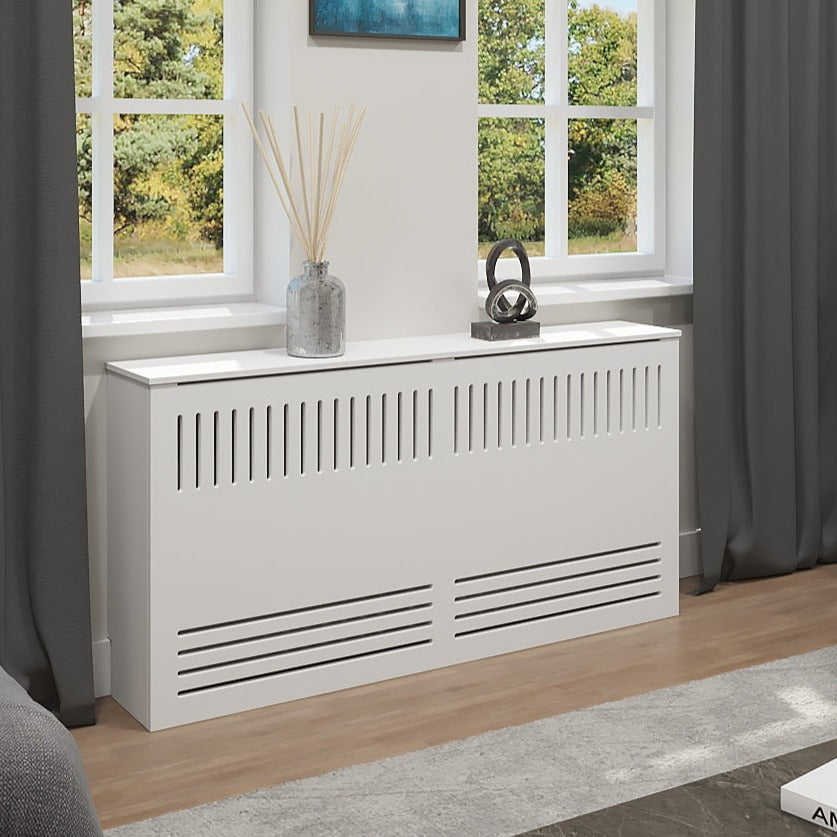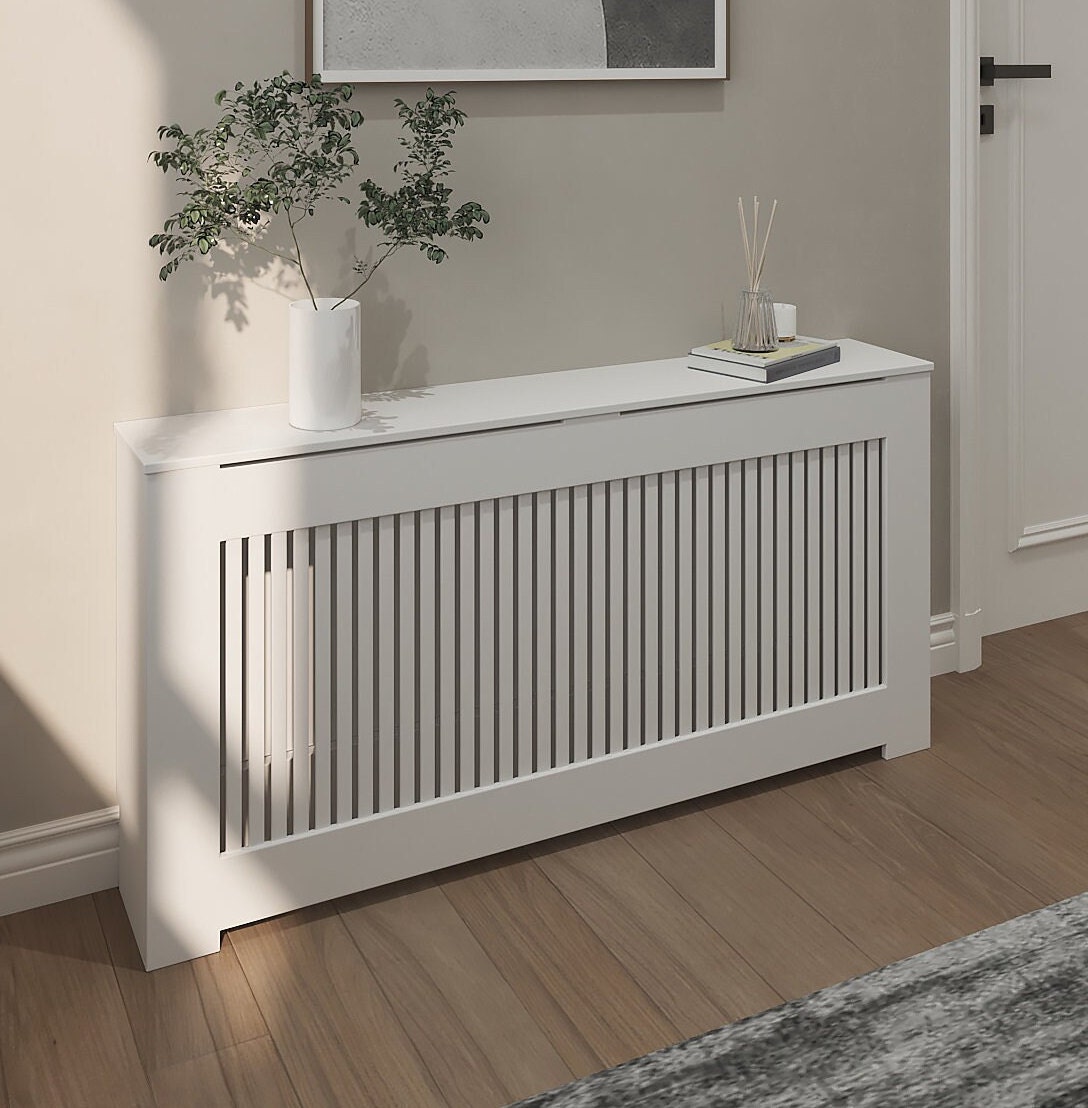10 Important Benefits of Using cheap radiator covers in Child-Friendly Homes
The Value of a Radiator Cover for Enhancing Home Visual Appeals and Safety
Radiator covers offer a twin function in the home, supplying both visual improvement and security benefits. They can change a practical burner into an elegant design feature, while also giving a barrier versus accidental burns. Choosing the best cover can greatly impact a room's atmosphere. Nevertheless, the choice of product and style can be tough. Understanding these facets is vital for any property owner seeking to stabilize design and safety properly.
The Useful Benefits of Radiator Covers
Radiator covers offer several practical benefits that enhance both the performance of heating unit and the general visual appeals of an area. Primarily, these covers assist to route heat extra uniformly throughout a room, stopping hot spots and guaranteeing a comfortable atmosphere. By encasing the radiator, they shield it from dirt and particles, which can hinder its performance. Additionally, radiator covers can reduce warmth loss by minimizing the amount of cozy air that leaves into unoccupied areas.Safety is one more vital aspect; covers can stop accidental burns, specifically in homes with youngsters or pets. Furthermore, they develop a barrier that discourages products from being put directly on the radiator, which can pose fire risks. Generally, radiator covers not just maximize home heating performance yet likewise add to a safer home, making them an important factor to consider for any home.
Enhancing Home Aesthetics Snappy
Radiator covers offer an unique chance to improve a home's aesthetic appeal via numerous layout choices. With a variety of materials, designs, and colors available, property owners can quickly coordinate these elements to match their indoor decor. This flexibility enables both capability and aesthetic improvement in any space.
Layout Adaptability Options
While lots of homeowners concentrate on functionality when picking home heating services, the visual charm of radiator covers need to not be forgotten - wood radiator covers. Radiator covers offer a variety of style adaptability, enabling them to seamlessly blend with numerous interior designs. From streamlined, modern layouts that enhance contemporary rooms to ornate, vintage-inspired covers that boost conventional style, there is a cover to fit every preference. In addition, personalized alternatives allow house owners to pick shades, patterns, and finishes that harmonize with their existing furnishings and wall surface therapies. This adaptability not just boosts the general visual of a space however likewise permits imaginative expression, transforming an usually overlooked element right into an elegant prime focus. Ultimately, the ideal radiator cover can elevate an area while keeping convenience
Product Options and Styles
Choosing the best products for radiator covers greatly effects both aesthetic appeals and performance within a home. Common materials include wood, steel, and MDF, each offering distinctive designs and benefits. Wooden covers emanate warmth and appeal, making them suitable for standard or rustic insides. Metal alternatives, commonly smooth and modern, give a modern touch while guaranteeing longevity. MDF, a versatile and affordable selection, can be quickly painted or finished to match any kind of decoration. The design style ought to line up with the total motif of the home, whether minimal, industrial, or classic. Inevitably, selecting the suitable material not just improves the visual appeal of the room however additionally ensures safety and security and effective warmth distribution, striking a balance in between type and function.
Color Sychronisation Techniques
Color coordination plays an important function in boosting home appearances, specifically when incorporating radiator covers right into the general style scheme. Picking a color that complements existing decoration can create a harmonious atmosphere. As an example, a neutral cover can mix seamlessly with wall surfaces, while a bold tone can work as a striking prime focus. Patterns or appearances can likewise be utilized to include depth and rate of interest, making certain the radiator cover contributes favorably to the space's setting. In addition, working with the cover's shade with furnishings or accents can merge the room. House owners need to consider the general shade scheme and lights, as these components influence exactly how colors communicate, inevitably improving both design and security within the home.
Security First: Shielding Your Household
Guaranteeing a risk-free home atmosphere is extremely important, specifically when young kids or family pets exist. Radiators, while necessary for heating, can position considerable risks. Their steel surface areas end up being very warm throughout operation, creating a threat of burns if touched. A radiator cover works as an effective obstacle, safeguarding prone member of the family from unexpected call with these heated surfaces.In enhancement to avoid burns, radiator covers aid to get rid of sharp sides and protruding components that could cause injuries. By confining the radiator, they likewise lower the possibility of things dropping onto the home heating component, which can produce fire risks. Furthermore, a properly designed cover can dissuade children from making use of the radiator as a play surface, consequently lessening the dangers of falls or various other crashes. Eventually, investing in a radiator cover not only improves the visual charm of a home but greatly adds to the security and well-being of its citizens.
Choosing the Right Product for Your Radiator Cover
When it pertains to picking a radiator cover, the product plays a considerable function in both capability and aesthetics. Common options consist of timber, metal, and MDF, each offering unique advantages (metal radiator moved here covers). Wood covers give a warm, classic look and can be conveniently tailored with stains or paints. Nevertheless, they might not be optimal for humid settings, as dampness can warp the product gradually. Steel covers, commonly made from steel or aluminum, deal longevity and a contemporary visual however may call for additional insulation to avoid heat loss. MDF is cost-effective and flexible, permitting for different coatings, though it may not endure high temperatures as well as various other materials. Ultimately, the option of material ought to straighten with the home owner's design choices, the intended location of the radiator cover, and any kind of particular practical demands, guaranteeing an ideal balance in between kind and feature

Design Concepts to Enhance Your Style
While a radiator cover serves a useful purpose, it can also enhance a room's total visual. Various style ideas can transform a basic cover into an eye-catching prime focus. For contemporary interiors, sleek steel or minimalist wood layouts can provide an advanced touch. In comparison, rustic homes could gain from recovered wood covers, website here which include heat and character.Painted radiator covers can perfectly blend with wall surface colors, creating a natural look, while formed materials can present appearance and visual interest.In spaces with a vintage vibe, luxuriant designs or ornamental grilles can stimulate a feeling of fond memories. Furthermore, integrating shelves in addition to the cover can supply useful space for plants or decorative things, further improving the decor.Ultimately, the choice of design should reflect the home owner's personal design, ensuring that the radiator cover enhances the total motif of the room.
Installment Tips for a Smooth Fit
Proper setup of a radiator cover starts with exact dimensions to assure a snug fit. Selecting the appropriate material is equally important, as it influences both functionality and visual charm. Adhering to these guidelines can significantly enhance the total appearance and effectiveness of the radiator cover.
Measure Your Radiator Precisely
Accurate measurements are crucial for accomplishing a smooth fit when installing a radiator cover. One should gauge the size, elevation, and deepness of the radiator, guaranteeing to capture the most protruding components. It is advisable to use a measuring tape for accuracy, keeping in mind dimensions in both inches and centimeters for flexibility. Additionally, gauging the distance from the floor to the top of the radiator aids in identifying just how high the cover should sit. Taking into consideration any pipelines or valves that may expand from the radiator can stop future problems. It is important to verify measurements to avoid mistakes, as even small inconsistencies can cause uncomfortable covers that compromise both aesthetics and capability.
Pick the Right Material
Picking the appropriate product for a radiator cover is crucial for both performance and aesthetics. Various products, such as timber, steel, and MDF, deal distinctive advantages. Wood supplies a cozy, timeless look however may require normal maintenance to stop warping. Steel is resilient and can withstand high temperatures, however may not mix flawlessly with all indoor styles. MDF, while economical and functional, may not be as heat-resistant original site as other choices. It is essential to take into account the desired environment; as an example, a bathroom might benefit from moisture-resistant products. Additionally, matching the cover with existing style boosts the overall layout. Eventually, the picked material needs to stabilize style, longevity, and safety to guarantee a seamless fit and long-term charm in any home.
Upkeep and Look After Radiator Covers
While radiator covers can boost the aesthetic allure of an area, their upkeep and treatment are essential for guaranteeing excellent performance. Routine cleaning is vital to avoid dirt buildup, which can block warm flow. Making use of a soft cloth or duster will be sufficient; harsh chemicals need to be stayed clear of to protect the surface of the cover.Inspecting the cover regularly for any kind of indicators of damage, such as rust or warping, is additionally essential. Immediate repair services can prolong the life-span of the cover and preserve its appearance. For wooden covers, periodic sprucing up might be essential to keep the finish intact and stop drying out or cracking.Additionally, ensuring that the cover is properly fitted and firmly affixed to the wall surface can stop mishaps, specifically in homes with youngsters or animals. By prioritizing upkeep, homeowners can delight in both the aesthetic and functional benefits of their radiator covers for years to come.
Frequently Asked Questions

Can Radiator Covers Improve Power Effectiveness in My Home?
Radiator covers can potentially improve power effectiveness by routing warmth into the area instead of shedding it directly to wall surfaces. This may bring about an extra consistent temperature and minimized power usage in time.
Are There Certain Radiator Cover Styles for Vintage Homes?
Radiator covers for classic homes usually include ornate designs, such as elaborate carvings or classic patterns - wood radiator covers. Styles like Art Deco or Victorian can enhance the home's style while offering functional advantages. Custom-made options are likewise readily available
How Do I Measure My Radiator for a Cover?
To measure a radiator for a cover, one ought to note the height, width, and depth. Furthermore, determining any type of projections or fixtures guarantees a proper fit, allowing the selection of an appropriate and practical radiator cover.
Can I Customize a Radiator Cover to Fit My Decoration?
Yes, tailoring a radiator cover to fit details style is possible. Choices include choosing materials, shades, and develops that enhance existing home furnishings, permitting a smooth combination into the overall visual of the room.
What Are one of the most Typical Products Utilized for Radiator Covers?
